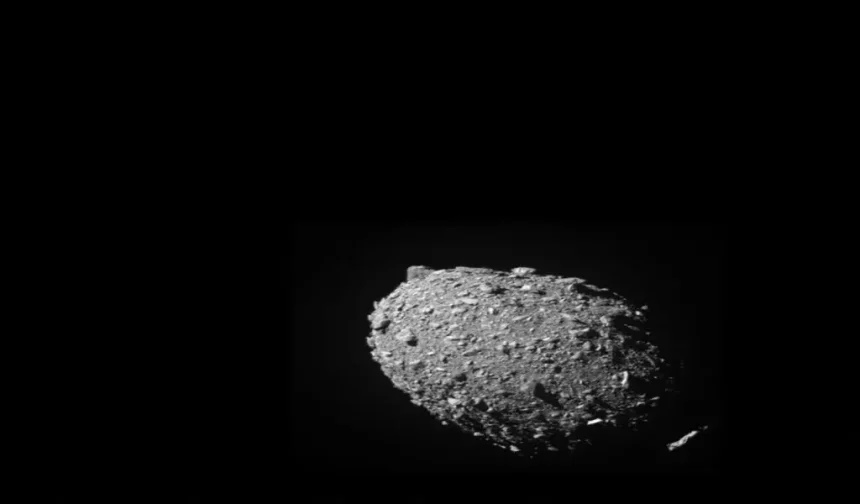(CTN News) – NASA’s DART satellite captured high-resolution pictures of the asteroids Dimorphos and its bigger companion Didymos just before the two collided in 2022 during a historic planetary defence test.
With the help of these photos, scientists have been able to piece together the complex history of these two nearby stony objects and learn more about how binary asteroid systems—primary asteroid systems with a secondary moonlet around them—form.
On Didymos, an examination of the craters and surface strength revealed that the planet formed around 12.5 million years ago. A comparable study revealed that Dimorphos originated around 300,000 years ago.
The researchers concluded that Didymos most likely originated in the main asteroid belt of our solar system, between Mars and Jupiter, and was subsequently thrown into the inner solar system.
The biggest rocks on Didymos and Dimorphos were examined, and the results provided information on the two asteroids’ origins.
The lead author of one of five studies on the asteroids published on Tuesday in the journal Nature Communications, astronomer Maurizio Pajola of the National Institute for Astrophysics (INAF) in Italy, stated, “Both asteroids are aggregates of rocky fragments formed from the catastrophic destruction of a parent asteroid.”
“These large boulders could not have formed from impacts on the surfaces of Didymos and Dimorphos themselves, as such impacts would have disintegrated these bodies,” Pajola said.
At around a half-mile (780 metres) in diameter, Didymos is categorised as a near-Earth asteroid. Dimorphos has a width of around 170 metres, or 560 feet. Both are “rubble pile” asteroids, made up of small fragments of stony debris that have come together due to gravity. There are large stones all over their surface.
The biggest on Didymos is as huge as a football pitch, but the largest on Dimorphos is the size of a school bus, said Olivier Barnouin, the main author of another study and planetary geologist and geophysicist at the Johns Hopkins University Applied Physics Laboratory in Maryland.
While Didymos may have finer-grained soils towards the equator, it is impossible to tell from the photographs we have. Dimorphos has fissures on its surface and in its rocks.
Both asteroids have weak surfaces—much weaker than loose sand,” said Barnouin.
Because of how quickly Dimorphos was spinning, the researchers concluded that it was made of material that had flown off the equatorial part of Didymos.
“In the case of Didymos, it is thought that in the past, it rotated faster around its axis due to the YORP effect (spin acceleration driven by the effect of sunlight on its uneven surface), and thus ejected the boulders from its equatorial region, forming Dimorphos,” Pajola said.
At the moment, Didymos rotates once every 2-1/4 hours. There weren’t many boulders in Didymos’ equatorial area.
“Its equator is much smoother, while mid-latitudes up to the poles are much rougher, with big boulders sitting on the surface,” Pajola said.
A proof-of-principle mission was conducted by the U.S. space agency’s Double Asteroid Redirection Test (DART) to show that a spaceship might apply kinetic force to alter the path of a space object that may otherwise be headed for Earth’s impact. There is no real danger from Didymos or Dimorphos to Earth.
At a speed of around 14,000 miles per hour (22,530 kph) and a distance of about 6.8 million miles (11 million kilometres) from Earth, DART impacted Dimorphos on September 26, 2022, to slightly alter its trajectory. Dimorphos’s form was also somewhat altered by the impact.
The knowledge of binary asteroid systems has increased because of the DART data. “Binary asteroid systems represent about 10–15% of the total number of asteroids that are in near-Earth space,” Barnouin said.
More broadly, our understanding of the formation and evolution of asteroids is expanded with each new observation of an asteroid or asteroid system. Despite being complicated systems, they share several important characteristics, particularly when it comes to the smaller asteroids that are less than a kilometre (0.62 miles) in size.”
Source: Yahoo News

Anna Wong serves as the editor of the Chiang Rai Times, bringing precision and clarity to the publication. Her leadership ensures that the news reaches readers with accuracy and insight. With a keen eye for detail,













